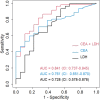Echogenic swirling pattern, carcinoembryonic antigen, and lactate dehydrogenase in the diagnosis of malignant pleural effusion
- PMID: 35260758
- PMCID: PMC8904853
- DOI: 10.1038/s41598-022-08188-y
Echogenic swirling pattern, carcinoembryonic antigen, and lactate dehydrogenase in the diagnosis of malignant pleural effusion
Abstract
The echogenic swirling pattern has a role in predicting malignant pleural effusion (MPE). However, its predictive ability is suboptimal, and its clinical utility remains to be defined. The aim of this study was to assess the diagnostic potential of the echogenic swirling pattern combined with pleural carcinoembryonic antigen (CEA) and routine laboratory tests of pleural effusion in MPE. The 80 consecutive patients with underlying malignancy and pleural effusions were recruited. All patients underwent one diagnostic thoracentesis with a cytologic examination of pleural fluid. Our study showed that the sensitivity of echogenic swirling patterns in MPE diagnosis was 67.7%, specificity was 72.2%, positive predictive value (PPV) was 89.4%, and negative predictive value (NPV) was 39.4%. Both CEA and lactate dehydrogenase (LDH) had acceptable sensitivity (71.0% and 60.7%) and specificity (72.2% and 77.8%). Combining the echogenic swirling pattern, pleural CEA, and pleural LDH, the highest sensitivity (95.2%) with a good PPV (86.8) was reached. In this clinical study, we found that combining the echogenic swirling pattern, pleural CEA, and pleural LDH had a higher sensitivity and a high positive predictive value for the diagnosis of MPE. This combination is a potentially suitable method for MPE screening in cancer patients with pleural effusions.
© 2022. The Author(s).
Conflict of interest statement
The authors declare no competing interests.
Figures
References
MeSH terms
Substances
LinkOut - more resources
Full Text Sources


